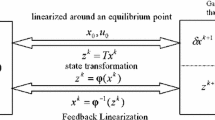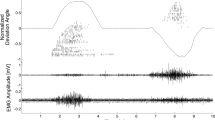Abstract
The goal of this paper is the learning of neuromuscular control, given the following necessary conditions: (1) time delays in the control loop, (2) non-linear muscle characteristics, (3) learning of feedforward and feedback control, (4) possibility of feedback gain modulation during a task. A control system and learning methodology that satisfy those conditions is given. The control system contains a neural network, comprising both feedforward and feedback control. The learning method is backpropagation through time with an explicit sensitivity model. Results will be given for a one degree of freedom arm with two muscles. Good control results are achieved which compare well with experimental data. Analysis of the controller shows that significant differences in controller characteristics are found if the loop delays are neglected. During a control task the system shows feedback gain modulation, similar to experimentally found reflex gain modulation during rapid voluntary contraction. If only limited feedback information is available to the controller the system learns to co-contract the antagonistic muscle pair. In this way joint stiffness increases and stable control is more easily maintained.
Similar content being viewed by others
References
Bizzi E, Dev P, Morasso P, Polit A (1978) Effect of load disturbances during centrally initiated movements. J Neurophysiol 41:542–556
Churchland PS, Sejnowski TJ (1992) The computational brain. MIT Press, Cambridge, Mass
Gerdes VGJ, Happee R (1994) The use of an internal representation in fast goal directed movements: a modelling approach. Biol Cybern 70:513–524
Gomi H, Kawato M (1992) Adaptive feedback control models of vestibulocerebellum and spinocerebellum. Biol Cybern 68:105–114
Gorinevsky DM (1993) Modelling of direct motor learning in fast human arm movements. Biol Cybern 69:219–228
Happee R (1992) Goal-directed arm movements. I: Analysis of EMG records in shoulder and elbow muscles. J Electromyogr Kinesiol 2:165–178
Katayama M, Kawato M (1991) A parallel-hierarchical neural network model for motor control of a musculo-skeletal system. Syst Comput Japan 22(6):95–105
Katayama M, Kawato M (1993) Virtual trajectory and stiffness ellipse during multijoint arm movement predicted by neural inverse models. Biol Cybern 69:353–362
Kawato M, Furukawa K, Suzuki R (1987) A hierarchical neural-network model for control and learning of voluntary movement. Biol Cybern 57:169–185
Kirsch FK, Kearney RE, MacNeil JB (1993) Identification of time-varying dynamics of the human triceps surae stretch reflex. I. Rapid isometric contraction. Exp Brain Res 97:115–127
Leshno M, Lin VY, Pinkus A, Schocken S (1993) Multilayer feedforward networks with a nonpolynomial activation function can approximate any function. Neural Networks 6:861–867
Nguyen DH, Widrow B (1991) The truck backer-upper: an example of learning in neural networks. In: Miller WT etal. Neural networks for control. MIT Press, Cambridge, Mass, pp 287–300
Sainburg RL, Ghilardi MF, Poiznar H, Ghez C (1995) Control of limb dynamics in normal subjects and patients without proprioception. JNeurophysiol 73:820–835
Werbos P (1988) Generalization of backpropagation with application to a recurrent gas market model. Neural Networks 1:339–356
Winters JM, Stark L (1985) Analysis of fundamental human movement patterns through the use of in-depth antagonistic muscle models. IEEE Trans Biomed Eng 32:826–839
Author information
Authors and Affiliations
Rights and permissions
About this article
Cite this article
Stroeve, S. Learning combined feedback and feedforward control of a musculoskeletal system. Biol. Cybern. 75, 73–83 (1996). https://doi.org/10.1007/BF00238741
Received:
Accepted:
Issue Date:
DOI: https://doi.org/10.1007/BF00238741




